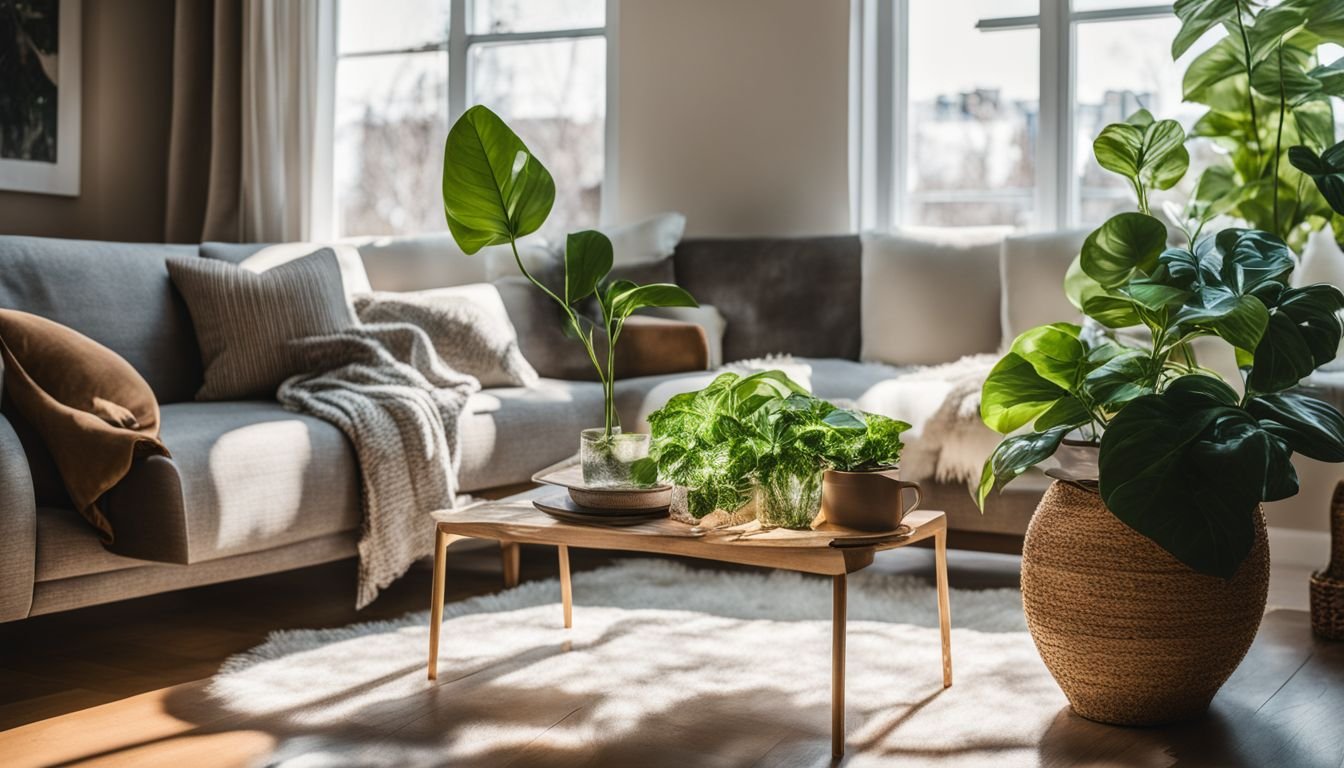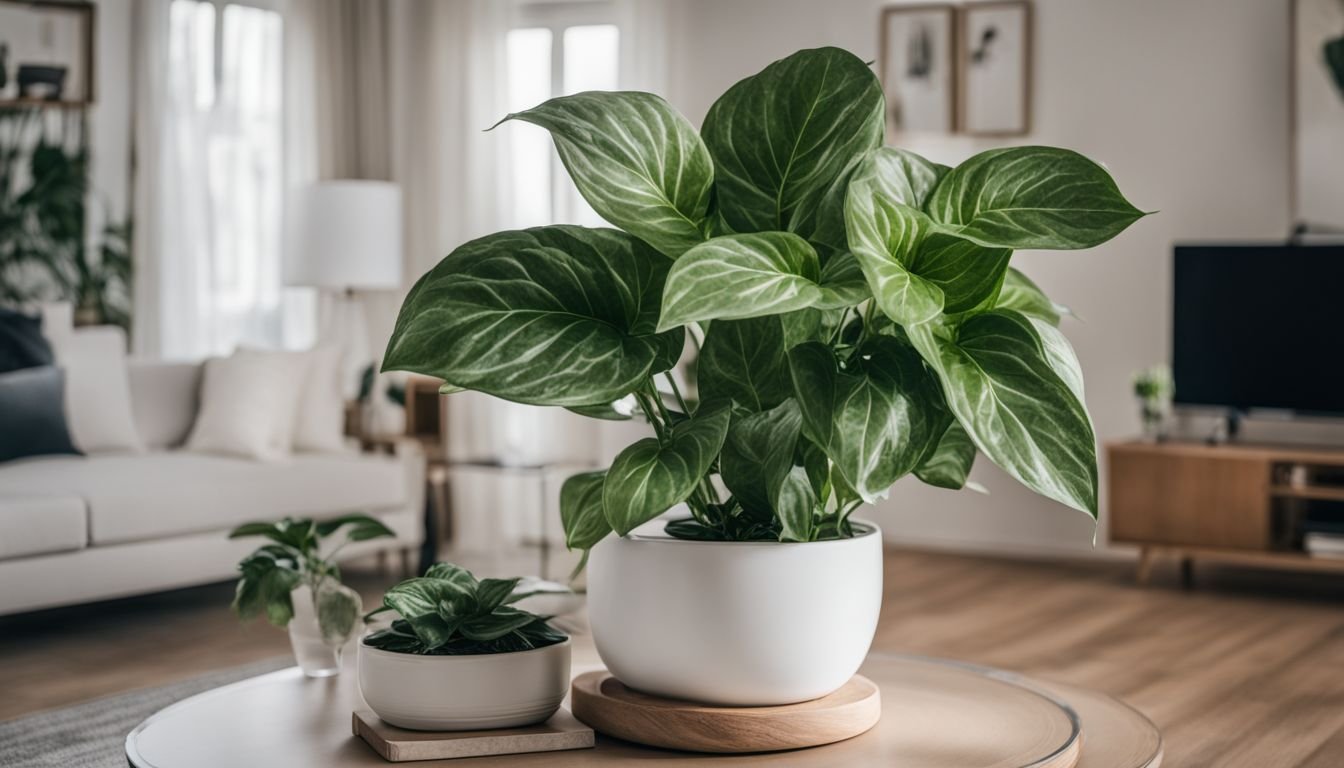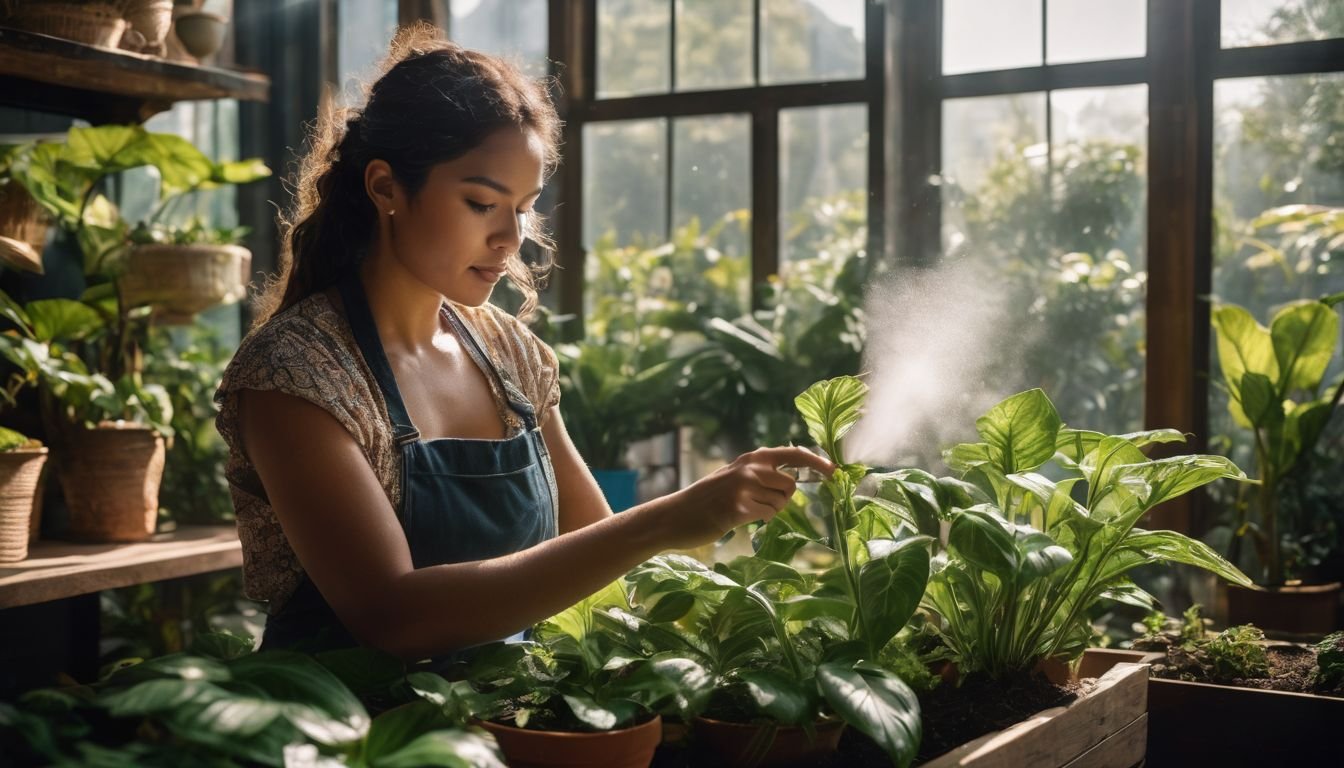Bringing a touch of elegance and pure Aussie charm into our homes, the White Syngonium plants have quickly become the go-to for plant enthusiasts down under. Yet, even with our best efforts, many of us find ourselves a bit stumped as to why these gorgeous indoor mates aren’t thriving as we’d hoped.
It’s a real head-scratcher—figuring out that fine line between showering them with too much love and not giving them enough attention.
We know all too well that feeling of looking at our less-than-perky White Syngoniums and secretly wishing they’d give us a hint on what we’re getting wrong. What we’ve come to realise is key: these beauties originate from tropical climates, yearning for humidity and dappled sunlight, pretty much begging us to recreate their natural vibes right here in Oz.
With this insight in mind, plus heaps more digging around for facts, we’ve pieced together some cracking strategies guaranteed to turn your plant care dilemmas into wins. Our guide’s geared up to help you get closer to understanding your leafy pals better so that they can flourish beautifully in your space—making it look like you’ve got the Midas touch when it comes to plants! So let’s dive in and get those thumbs greener than ever before! Keen for a read?.
Key Takeaways
- Give your White Syngonium plants a spot where they can enjoy indirect sunlight, just like their natural tropical habitat. Direct sun can harm them, so find a place that gets bright but not direct rays.
- Keep the soil moist by watering regularly during the first 12 weeks to help establish strong roots. After that, let the soil dry out a bit before watering again to keep your plant happy and healthy.
- Increase humidity around your plants because they love it! Mist their leaves often or use a room humidifier to keep them thriving. This also keeps spider mites at bay, which hate moist conditions.
- Watch out for spider mites and treat any outbreaks promptly with insecticidal soap or neem oil solution. Regular leaf cleaning helps prevent these pests from making themselves at home on your plants.
- Feed your White Syngonium with half – strength liquid fertiliser every couple of weeks after the initial establishment period to support lush growth and beautiful foliage.
Understanding White Syngonium Plants

Diving deep into the world of White Syngonium plants reveals a fascinating variety perfect for indoor gardening enthusiasts. These elegant plants offer more than just stunning foliage; they bring a touch of nature’s magic right into our homes.
Syngonium White Butterfly
We all appreciate the charm and beauty that indoor plants bring to our homes, and Syngonium White Butterfly stands out for its unique appearance. Its leaves dazzle with pale green tones crowned by a captivating white centre, making it not just another house plant but a striking piece of living art.
This variety’s appeal isn’t just in its looks; the amount of white and green on each leaf varies according to light exposure and individual plant characteristics, ensuring no two plants look exactly alike.
Caring for a Syngonium White Butterfly requires understanding its need for a humid environment away from direct sunlight. We find they thrive best in shady spots where indirect sunlight brightens their day without scorching their delicate foliage.
A good quality potting mix or well-draining soil lays the foundation for prosperity, along with regular watering routines during the initial 12 weeks post-planting. After this establishment period, we cut back on watering, waiting until the soil feels dry before giving them another drink paired with half-strength liquid fertiliser every couple of weeks.
This specific species enjoys humidity which can often be achieved inside Australian homes through simple methods like placing water trays near heating systems or using room humidifiers during drier seasons.
Keeping an eye on growth allows us to maintain an ideal size through pruning, ensuring they don’t exceed their typical 50cm height and width dimensions while also encouraging denser foliage development.
As passionate gardeners always seeking to enrich our living spaces with greenery that purifies air and delights senses — adding a Syngonium White Butterfly brings both aesthetic value and satisfaction in nurturing these exquisite plants within our own four walls.
Syngonium ‘White Knight’
Moving from the delicate allure of the Syngonium ‘White Butterfly’, we delve into the striking beauty of Syngonium ‘White Knight’. This variety captivates with its large, arrow-shaped leaves that boast a unique combination of pale green and vibrant white centers.
It’s a standout plant that adds an exotic touch to any room or tropical garden. Despite its tropical origins, it adapts well to indoor settings, thriving in pots where its foliage can truly shine.
For those considering adding this stunner to their collection, know that it demands some attention to maintain its stunning appearance. The ‘White Knight’ prefers a well-lit spot without direct sunlight beating down on it, ensuring those distinctive leaves don’t lose their variegation.
Watering should be regular but moderate – allowing the potting soil to dry out slightly before giving it another drink prevents root rot and keeps the plant healthy. And while indoors might shield it from many pests, keep an eye out for spider mites which are drawn to indoor conditions.
Outdoor enthusiasts can introduce Syngonium ‘White Knight’ into temperate or semi-arid micro-climates as long as they monitor growth closely due to its climbing tendency; careful pruning helps keep it within bounds especially near bushlands where overgrowth could pose a problem.
Whether used as groundcover in shaded areas or featured prominently in hanging baskets, this versatile plant ensures an impressive display wherever placed – proving yet again why these foliage plants have become such beloved features in homes and gardens across Australia.
Benefits of White Syngonium Plants

White Syngonium plants bring more than just aesthetic appeal to our homes; they actively clean the air we breathe. Their versatility allows them to adapt in various roles, be it as lush groundcovers or eye-catching potted gems.
Air-purifying capabilities
We often overlook the air we breathe inside our homes, but White Syngonium plants offer us a fantastic solution to improve it. These beauties are not only eye-catching with their lush, arrowhead-shaped leaves but also work hard to purify indoor air.
They do this by absorbing pollutants such as benzene and formaldehyde, common in household products, thereby providing us with cleaner air.
Keeping these plants around can make a significant difference in our living spaces. They actively contribute to reducing airborne toxins and enhancing overall indoor air quality. It’s like having a natural air purifier that also adds aesthetic value to your home.
So, whether placed in the living room or the office, they tirelessly work towards creating a healthier environment for us all.
Versatility: groundcover, trailing/climbing vine, or potted specimen
Our love for White Syngonium plants stems not only from their air-purifying capabilities but also from their incredible versatility. These plants seamlessly adapt to different roles within the home garden, whether as a lush groundcover that fills in those bare patches under taller plants or as an eye-catching trailing vine that adds depth and texture when draped elegantly over shelves or baskets.
Their compact size of approximately 50cm x 50cm ensures they fit perfectly into various spaces without overtaking the area.
Choosing to grow them in pots presents another dimension of styling these versatile houseplants. Potted White Syngoniums become stunning focal points on tables or desks, embodying the essence of a miniature indoor jungle.
The ability to prune them according to preference allows every gardener to shape their growth, encouraging denser foliage or longer vines that showcase their arrowhead-shaped leaves more prominently.
This adaptability makes it straightforward for any plant lover to incorporate these beauties into their homes, regardless of available space.
Caring for them involves acknowledging their need for regular watering and protection against common pests like spider mites, ensuring they remain healthy and vibrant in whichever form they take within our gardens.
Through careful consideration of light conditions and occasional application of mulch or worm compost around potted specimens, we can support robust growth whether they’re spreading across the ground, climbing up structures, or thriving atop our favourite stands.
Key Care Tips for White Syngonium Plants
Caring for White Syngonium plants means keeping an eye on their unique needs, ensuring they thrive in your home. We’ll guide you through establishing the perfect environment for these charming houseplants, focusing on lighting, watering habits, and safeguarding them from pesky pests like spider mites.
Ideal light conditions
We know you’re keen to give your White Syngonium plants the best chance at thriving, and light plays a crucial role in this. These plants flourish under indirect sunlight in a shady spot that mimics their natural, humid habitat.
It’s all about finding that sweet location where your plant can bask in brightness without being scorched by direct sun. Think of it as providing a cosy nook with plenty of soft, filtered light.
Ensure they’re placed in an area where the lighting is gentle yet sufficient throughout the day. This approach helps preserve their stunning foliage while promoting healthy growth.
Remember, too much direct sunlight can harm your White Syngoniums by causing leaf burn or fade, so we aim for a balance between shade and light. With just the right amount of indirect sunlight, you’ll see your arrowhead vine flourish inside your home, bringing green lushness and air-purifying benefits to your space.
Watering needs
After ensuring your White Syngonium receives the ideal light, focusing on its watering needs becomes crucial to its health and growth. During the initial 12 weeks, it’s vital to water these plants regularly to support their developing root systems.
This sets a strong foundation for their overall vitality. Once established, assess the soil’s moisture before deciding to water; only do so if it feels dry.
White Syngonium thrives in humid conditions similar to its natural tropical habitat, making regular misting of the leaves an excellent practice. This not just meets their love for humidity but also discourages spider mites from settling in.
It’s a simple yet effective way to keep your plant looking fresh and healthy while maintaining optimal growth conditions without overcomplicating things.
Prone to spider mites: prevention and treatment
Ensuring your White Syngonium plants receive the right amount of water sets a healthy foundation, but it’s also vital to protect them from common pests like spider mites. These tiny critters thrive in dry conditions, making our beloved houseplants vulnerable.
Regularly misting your White Syngonium increases humidity around the plant, creating an environment that’s less appealing to spider mites. Additionally, make it a habit to inspect the leaves for any signs of infestation which can include webbing or discolored spots on the foliage.
If you do spot spider mites on your plant, don’t panic. You can treat the infestation effectively with gentle solutions that won’t harm your precious Syngonium. A mixture of insecticidal soap or neem oil diluted in water makes for an excellent remedy against these pests.
Simply spray this solution onto the affected areas of your plant, ensuring to reach undersides where mites often hide. Alongside these treatments, wiping down each leaf with a damp cloth not only removes dust but also any lingering mites or eggs.
We must keep vigilant care routines for our syngonium podophyllum and understand that prevention is just as crucial as treatment when dealing with spider mite outbreaks It requires consistent effort and attention; however, maintaining high humidity through regular misting and keeping those leaves clean will significantly reduce the risk of infestation This ensures our green companions remain healthy and vibrant parts of our homes.
Exploring More on Syngonium Plant Varieties and Care Tips
Discovering the vast family of Syngonium plants opens up a world of diversity and beauty in our homes and gardens. Each variety, from the ‘White Butterfly’ with its delicate patterns to the bolder ‘White Knight’, brings its unique charm and benefits.
As lovers of plants, we appreciate their ability not only to beautify spaces but also to purify the air we breathe. Ensuring these tropical natives thrive involves understanding their specific needs — light exposure, humidity preferences, and watering routines.
Tackling care requirements head-on means acknowledging that while Syngonium plants love humid conditions reminiscent of their natural habitat, they also demand protection from direct sunlight which can scorch their leaves.
We integrate them into our living spaces by choosing spots where indirect light brightens their day without overwhelming them. Watering practices are refined over time; too much enthusiasm can lead to soggy soils whereas a more measured approach ensures just the right level of moisture.
This balance supports lush growth without inviting unwelcome guests like spider mites.
Incorporating worm castings into the soil or potting mix at planting provides an initial nutrient boost that encourages strong root development for our Syngoniums. Subsequent feeding with liquid fertiliser at advised rates promotes vibrant foliage display throughout growing seasons, making every corner hosting these spectacular specimens a focal point of natural beauty.
Conclusion
Caring for your White Syngonium plants brings a slice of tropical beauty into your Australian home. Remember, they thrive in humid, shady spots with indirect sunlight and enjoy a good spritz to keep their leaves vibrant.
Regular trimming keeps them tidy, enhancing their charm. Embrace these tips and watch as your space transforms with the lush greenery of White Syngoniums. Let’s make our homes greener and our air cleaner, one plant at a time.
FAQs
1. What do I need to properly care for a White Syngonium plant in my home?
Caring for a White Syngonium, also known as the arrowhead plant, requires regular watering to keep the soil moist but not waterlogged, access to bright indirect light, and occasional pruning to remove any dead or yellow leaves.
2. Can White Syngonium plants survive outdoors in Australia?
White Syngonium plants thrive best indoors as houseplants in Australia due to their preference for warm temperatures. They can struggle with the frosts common in some Australian regions when placed outside.
3. How often should I repot my White Syngonium plant?
Repotting your White Syngonium every two years or when it outgrows its current pot promotes healthy growth by providing fresh soil and more room for root development.
4. Are there any common pests or problems I should watch out for with my White Syngonium?
Keep an eye out for weeds that might compete with your plant’s resources if you have it in a larger container or an indoor hedge setting. Common indoor pests like spider mites can also be an issue; regularly inspecting and cleaning the leaves can help prevent infestations.
5. What are some tips for ensuring my White Syngonium stays healthy and vibrant?
Ensure your plant receives plenty of indirect sunlight, avoid overwatering by letting the top inch of soil dry between waterings, and provide a balanced liquid fertiliser during growing months to support vibrant foliage on your arrowhead plant.
